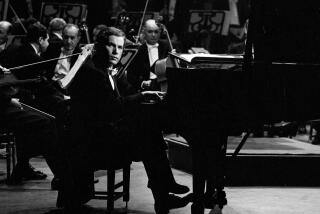Essentials of That Eccentric Glenn Gould
The eccentricities of Canadian pianist Glenn Gould were better known to most of the world than his artistic achievements.
Few media-watchers of the 1950s and ‘60s were unaware of Gould’s practice of soaking his hands in boiling water before a performance, his arguments with piano benches (and conductors), his stentorian groaning while playing, his (in the earliest days) signature, yards-long scarf and demand for tropical temperatures in the recording studio.
And then there was his single, most dramatic act: his withdrawal in 1964, at age 32, from performing in public in favor of the recording studio and appearing on Canadian radio and TV to give lecture demonstrations, as well as to engage in various writing projects, including his now-widely respected documentary films on the Canadian wilderness.
He died in 1982, at age 50, after suffering a massive stroke.
Gould at one point wrote that it was impossible to reconcile the presence of an audience with “the essentially private act of music-making . . . music is much more cogently and creatively served by the recording studio or via any medium which permits one the luxury of second-guessing, so to speak, the interpretive decision.”
Yet, during his concert career, which lasted only some dozen years, he was a decidedly public figure, performing, talking (wittily, brilliantly, charmingly and, always, provocatively) and recording a limited repertory.
That repertory was based largely on Bach and Beethoven, with excursions into such relative esoterica as Hindemith (whom he admired, typically, as a contrapuntalist), contemporary Canadian composers and a few major or minor masters not usually identified for their contributions to the piano literature, such as Bizet, Sibelius and Richard Strauss.
And there was a good deal of Mozart, whom Gould claimed to dislike--except when he resembled Bach.
In Sony Classical’s massive “Glenn Gould Collection,” to date some 16 mid-price CDs reissues, some multiple-disc sets, of material recorded by Columbia both during and after the Gould concert career, one makes strong contact with Gould the pianist.
Regarding those CDs, let’s cut right from the quantity to the quality, or what is essential.
Gould made his international reputation with the 1955 recording of Bach’s “Goldberg” Variations, whose release was attended by some of the most spectacular hype in modern musical history: more the marketing of Gould’s weirdness than his musical gifts.
That performance (52594) retains its refreshing clarity and vitality in Sony’s superbly clean remastering.
There’s plenty of other Bach, too. But it seems less important nowadays then it did then, exhibiting a certain mechanical sameness, considerations of authenticity aside.
If this listener were asked to name the Gould performances of most lasting value, the “Goldberg” would be among them. But also the Beethoven concertos, recorded between 1957 and 1966 (52632, four CDs), and Mozart’s C-minor Concerto from 1961 (52626).
No less than in his Bach, Gould’s primary aim in Beethoven was to clarify structure, above all the contrapuntal lines, a pursuit in which he made the left hand more than an equal player, frequently highlighting its part, consciously, at the expense of the right, the source of most pianistic activity.
In the process, Gould wound up on a tack radically different from that taken by other interpreters: an espousal of Beethoven’s music more rooted in the Baroque and Classical past than in a heralding of Schubertian, Wagnerian and Brahmsian Romanticism.
The First Concerto is a keen-edged dashing romp, with Gould’s nimble pianism spiritedly seconded by Vladimir Golschmann’s quick-witted direction of the Columbia Symphony.
Although Gould claimed not to care much for the Third Concerto, you’d never know it from this lucid, light-fingered but no means picky reading, with the sentimental musings of the slow movement, where one might imagine the pianist’s attention to wander, most sensitively projected. Leonard Bernstein is the sympathetic conductor of a scrappy Columbia Symphony here.
While the Second Concerto is rushed and coarsely recorded, one can only be puzzled by what Gould and his collaborator, Leopold Stokowski, were trying to say in their drab, slow-motion “Emperor.” The G-major Concerto-the Fourth--is given the performance of a lifetime by the pianist and Leonard Bernstein, this time conducting the New York Philharmonic.
Although Gould may have been fixated on linear clarity, he did not inevitably wed this approach to strictest rhythmicity--in which respect he is a precursor of today’s period specialists.
In the G-major Concerto, Gould plays with the subtlest rhythmic flexibility and great variety of tone--although still within Gouldian limits. The concentration he brings to the darkest of Beethoven’s slow movements suggests bottomless emotional depths, while the finale here partakes of an unlikely mixture of stateliness and bacchanalian joy.
Gould’s desiccated, clockwork Mozart style is temporarily abandoned in his hugely dramatic interpretation--and, of course, one which at the same clearly exhibits the score’s inner workings--of the C-minor Concerto, K. 491, in other hands the most Romantic of the composer’s keyboard works and therefore partaking least of the pianist’s predilection for Mozart-that-sounds-like-Bach.
Yet Gould is as much taken with its theatrical aspects as with its disciplined structure--a quality Mozart, in Gould’s eyes, generally lacked. The pianist’s colleagues here are the players of the Toronto-based CBC Symphony under the direction of Walter Susskind.
The remainder of this program, however, finds Gould at his most anti-Mozartean, applying nasty little finger chops to the blithe Sonata in C, K. 330, and leading us into the depths of Strange City with Haydn’s great Sonata in E-flat, Hob. 49, which he freeze-dries into a textbook contrapuntal exercise.
More to Read
The biggest entertainment stories
Get our big stories about Hollywood, film, television, music, arts, culture and more right in your inbox as soon as they publish.
You may occasionally receive promotional content from the Los Angeles Times.










